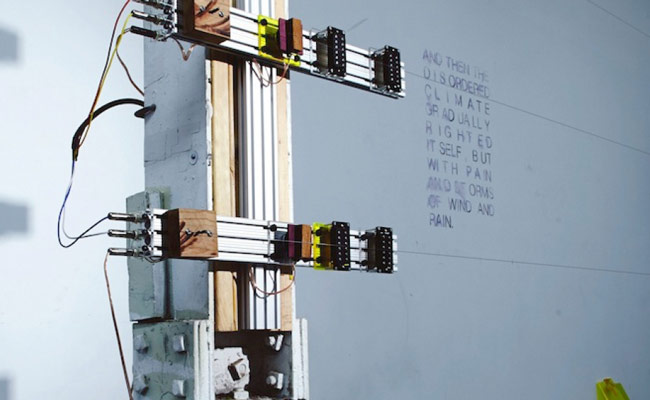The new exhibition at the Science Gallery explores traumas. The word trauma derives from the Ancient Greek word meaning “wound”, and this exhibition has ambitiously expanded the concept of trauma to encompass not only wounded bodies and wounded minds, but also wounded cultures, and even a wounded planet. In the wake of terrorist atrocities in Paris, Beirut and Baghdad, this exhibition could not be more pertinent. Particularly important is the way the exhibition seeks to explore human resilience and recovery in the face of trauma. We might come here not only for enlightenment but for healing too.
There is such a plethora of brilliant artworks in this exhibition, in many ingenious mediums. But there is one exhibit that stands out. Project Syria explores a global trauma, the Syrian Civil War and the resulting refugee crisis. Through “Virtual Reality Storytelling”, Project Syria seeks to give us an experience of the calamitous predicament of millions of refugees.
Project Syria uses Vive technology, a virtual reality head-mounted display. It’s immersive journalism. Instead of giving us a print description of a rocket attack which occurred in Aleppo, Syria, on November 6th 2012, using a Vive headset, we are given an experience of the attack as a virtual witness. The 3D virtual reality is quite exact. Nonny de la Peña, the pioneer behind Project Syria, rebuilt the scene using actual footage and audio captured during the attack.
When you put on the Vive headset, you are transported. Oblivious of the room, the Aleppo market-place becomes your new reality. Look up at the hot sky. Look round at the children playing. You can walk down the road towards the street-sellers touting their wares. Hear the sounds of the bustling market. A man walks towards you: stand aside to let him by.
Suddenly, the rocket hits and all is confusion. Smoke, human screams. You can’t see much because there’s dust everywhere. But someone is cradling a body nearby. It’s a child.
Then this all dissipates and you find yourself standing in a camp with shanty dwellings around. Zaatari refugee camp in Jordan. The camp has received a huge influx of refugees since 2011. You experience this population explosion in a kind of time lapse. As you look around, the camp is becoming more and more crowded. More human figures are materialising out the air. Are some of these survivors of the rocket attack you just witnessed in Aleppo?
But suddenly you’re in a food tent in the camp. Behind the counter. Next to someone serving food. At first the people taking the food are civil. There’s not many of them. Until more and more people begin to materialise and soon there’s not enough food and the people are baying for something to eat. And there’s nothing.
Dazed, you take off the headset and return to the room, almost drunkenly. Have you woken from a horrific dream? The girl who used the headset before he broke down afterwards, sobbing on the floor until the technician came to console her. If we are indeed guilty of indifference in the face of the atrocities in Syria and the resulting refugee crisis, this is one startling way to elicit compassion.
It’s important to note that the full experience of the Vive headset is only available until Monday.
And there’s so much more. The beauty of this exhibition is its multifariousness.
Colm McNally’s Grasp I, II, and III give you an experience of traumatic disability. Grasp I encourages you to operate a prosthetic arm. Grasp II asks you to put on stiff gloves and open jars, simulating arthritis. Grasp III uses a two-way mirror to create an illusion that your arm has been lacerated.
Jane Prophet’s Second Skin articulates her experience of being stalked for 25 years. David Cotterrell’s series of photographs graphically examine the medical treatment given to wounded soldiers in conflict zones.
William Utermohlen’s Self-Portraits deals with Alzheimer’s, a disease which eventually killed him in 2007. The artist recorded his worsening condition through self-portraiture over a span of forty years. The four self-portraits (1967, 1996, 1997, 2000) powerfully articulate a feeling of disintegration. The final portrait, painted a few years before his death, shows the artist as an abstract figure, warped and distorted beyond recognition.
Memory Laundering explores how traumatic experiences are processed and distorted by memory. The exhibit invites you to write down on paper two memories from the past week – one good, one bad. You then place the paper in a cabinet with numbered lockers and, taking the key, wander off to view the rest of the exhibition. Unbeknownst to you, there’s someone hidden behind what is a false cabinet. While you’re away, they edit slight details of the memory. On returning, you’re surprised to notice changes in the memories.
This process seeks to replicate the faculty of memory, and the way it alters remembered experiences in the mind. We might, therefore, question the truthfulness of traumatic experiences as we remember them. Is there thus some truth in the notion that traumatic events become fictions in the mind?







